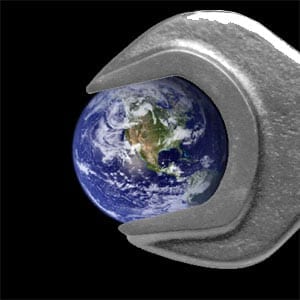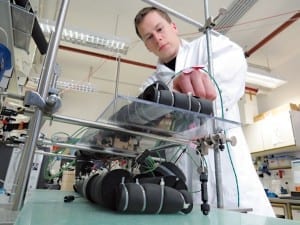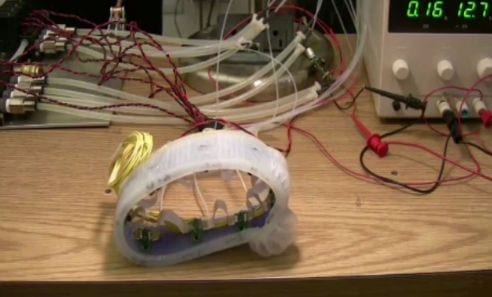
The technologists’ dream of remaking the planet to live with our carbon emissions is here. How do we stop one panicked country from deciding it’s time to press the button?
Here’s a scenario that seems plausible if we continue down our current path of only vaguely paying attention to climate change: There’s a drought in northern China, almost certainly exacerbated by global warming. People are dying. There’s famine and huge waves of migration out of the region. The government, not known for being calm in a crisis, faces enormous social unrest, and so it resorts to a drastic plan to change the weather, spraying sulfate aerosols—a combination of water vapor and sulfur—out of jets flying high in the sky. The wind carries the aerosols across the planet, eventually increasing the Earth’s albedo (its ability to reflect sunlight back into space) enough that the process of global warming is offset, even if greenhouse gas levels continue to build up in the atmosphere. The earth’s warming is alleviated for a time and, as a result, so are China’s droughts.
The operation wouldn’t cost much in the grand scheme of the world’s largest economies—on the order of billions of dollars per year, according to David Keith, one of the most prominent geoengineering proponents and a professor of applied physics and public policy at Harvard—and a sulfate aerosol spraying initiative with global ramifications could be done from a single airbase. The aerosol spraying could make the sky whiter, perpetually reminding us of how we’ve altered the climate. But how much would that matter if the world could preserve itself as it is today, avoiding the inevitable die-offs from long-term climate change? And in any case, how could the global community stop a country like China or India if it wanted to implement a geoengineering scheme without consent from the rest of the world?
These aren’t rhetorical questions. Over the last few months, scientists have started to more seriously tackle the questions surrounding geoengineering’s ramifications. And there’s a real possibility that altering the environment will be an option on the table at the upcoming international climate talks. If we have the technology, some countries—especially ones that didn’t get to reap the benefits of pumping out a planet-destroying amount of carbon—might argue, why aren’t we using it?
Sulfate aerosol spraying has a huge downside: once you start, you can never stop.
The sulfate aerosol scenario, a type of solar-radiation management (SRM), isn’t the only way to engineer the Earth’s climate so that it suits humanity’s needs, but because it’s relatively cheap and easy, it is one of the most likely schemes to be implemented. The concept of SRM has been around for decades, but interest in the topic has skyrocketed in the past few years, as the scale of climate change’s potential destruction has emerged. Sulfate aerosol spraying has a huge downside, however: once you start, you can never stop. A halt in the scheme would cause temperatures to rise rapidly, with potentially catastrophic results.
WHAT WE’RE CAPABLE OF
The concept of geoengineering goes back to at least the mid-1800s, when meteorologist James Pollard Epsy posited a method for generating artificial rain during droughts. In the 1960s and 1970s, geoengineering on a large scale started being taken seriously, as the former USSR considered ways to warm its tundra and turn it into farmland, according to the U.K.’s Royal Society.
Today, there are two basic approaches for geoengineering planetary systems to reduce climate change: SRM and removing carbon dioxide from the atmosphere (Keith is president of a company called Carbon Engineering that has developed a technique for capturing CO2 from the air). Unlike SRM, scrubbing CO2 from the atmosphere eliminates the root cause of climate change (removing CO2 from the atmosphere) instead of just alleviating the symptoms (cooling the planet, but leaving greenhouse gases in the atmosphere). But it has its downsides—what should be done with all the captured CO2? Companies in the space have a variety of ideas, including making plastic and fuel out of scrubbed CO2.
Read more: Now That We Can Geoengineer The Planet, What If Someone Decides To Actually Do It?
The Latest on: Geoengineering
[google_news title=”” keyword=”Geoengineering” num_posts=”10″ blurb_length=”0″ show_thumb=”left”]
via Google News
The Latest on: Geoengineering
- Longer-lasting ozone holes over Antarctica expose seal pups and penguin chicks to much more UVon April 28, 2024 at 9:30 am
If ozone holes last longer, summer-breeding animals around Antarctica's vast coastline will be exposed to high levels of reflected UV radiation. More UV can get through, and ice and snow is highly ...
- Solar geoengineering is gathering steam in the tech world as a climate solutionon April 28, 2024 at 5:04 am
Solar geoengineering — increasing the sunlight reflected back into space to cool the planet — is gaining the attention of people looking for climate solutions. But critics say it comes with risks.
- Scientist Slams Politicians For Banning Geoengineering Experimentson April 27, 2024 at 3:01 am
A climate scientist is warning against regulatory attempts to quell weather-changing technology, which seeks to cool the planet through various means as climate change keeps heating it up. In an ...
- Opinion: Progress in responding to climate emergency? Not if emissions are at an all-time highon April 26, 2024 at 10:52 pm
Not only are China and India polluting more than ever, a global backlash to policies that require personal sacrifice is evident. This messy picture isn't encouraging.
- Ozone hole: Why Antarctic wildlife is being 'sunburnt’on April 26, 2024 at 4:12 pm
A hole in the ozone layer - the protective barrier of gas in the upper atmosphere - now lingers over the frozen continent for more of the year. A major cause of ozone loss is believed to be the amount ...
- Controversial methods to cool the Earth by reflecting sunlight gain traction as global temperatures riseon April 26, 2024 at 2:20 pm
Relatively untouched ideas are gaining momentum as potential short-term solutions to lower Earth's temperature.
- Solar geoengineering to cool the planet: Is it worth the risks?on April 25, 2024 at 8:53 am
When I first wrote about geoengineering in 2012 , it was considered far-fetched at best, and crazy by most. But 12 years later, while there is still controversy and considerable resistance to ...
- MIT Technology Reviewon April 23, 2024 at 1:46 pm
We need more research, including outdoor experiments, to make better-informed decisions about such climate interventions.
- Geoengineering could save the ice sheets – but only if we start soonon April 22, 2024 at 6:02 am
Shading the planet by spraying aerosols into the stratosphere might stave off ice sheet collapse, modelling studies suggest, but we are running out of time ...
- What is geoengineering?on April 16, 2024 at 8:35 am
What does this term mean—and why is it so controversial? In 2009 Britain’s Royal Society, a scientific academy, defined geoengineering as “the deliberate large-scale manipulation of the planetary ...
via Bing News










